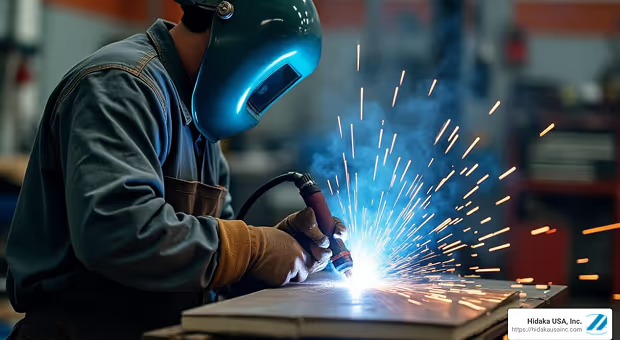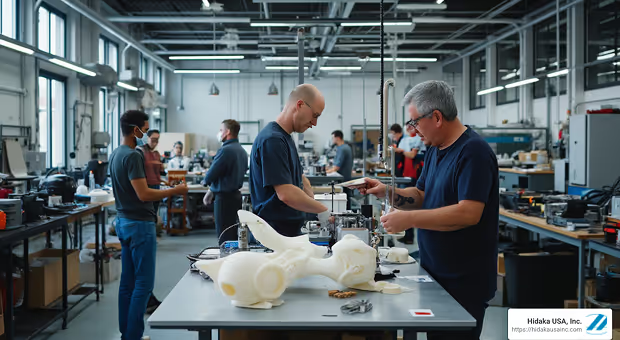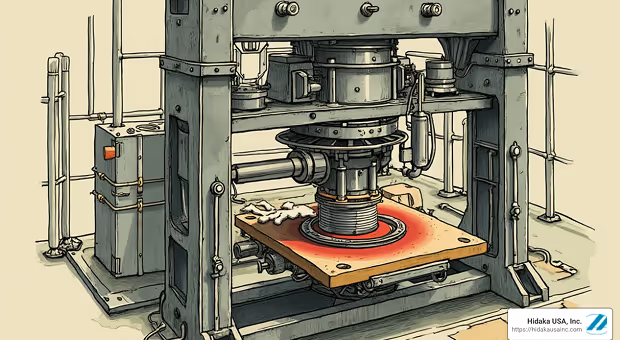Auto body panel welding is a crucial skill for anyone looking to repair or restore vehicles. Whether you're working on a cherished vintage car or a modern model, understanding how to join body panels efficiently and effectively is key.
Here's a quick guide to get you started:
- MIG Welding: Best for beginners, uses shielding gas and filler wire.
- TIG Welding: Offers precision with minimal distortion, ideal for thin panels.
- Stick Welding: Known for versatility, suitable for strong, deep welds.
Mastering these techniques can be challenging due to the thinness of auto body panels and the risk of warping. Successful welding requires precision, the right equipment, and practice. While vintage cars often demand welding for restoration, modern vehicles typically use replacement panels, enhancing efficiency but introducing different challenges.
In this guide, we'll dive deep into the nuances of both manual and robotic welding techniques, offering insight into overcoming common problems in auto body panel welding.
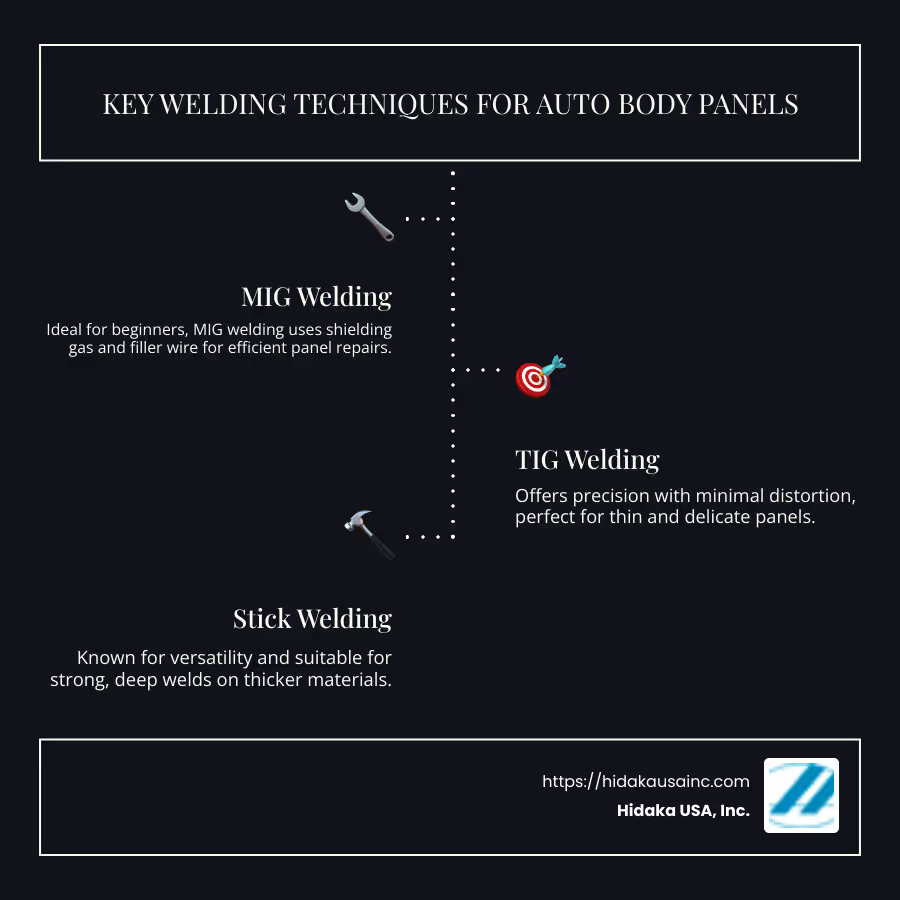
Understanding Auto Body Panel Welding
When it comes to auto body panel welding, understanding the different techniques is essential for achieving strong and smooth welds. Let's explore three primary methods: MIG welding, TIG welding, and resistance welding.
MIG Welding
MIG welding is often the go-to choice for beginners and professionals alike. It's popular because it's straightforward and efficient. This method uses a continuous wire feed as a filler material, along with a shielding gas like argon or CO2 to protect the weld from contamination.
- Ease of Use: MIG welding is user-friendly, making it ideal for those new to welding. The automatic wire feed allows for continuous operation, speeding up the process.
- Common Uses: It's great for general repairs and is particularly effective on thicker metals.
TIG Welding
TIG welding is known for its precision and ability to produce clean, high-quality welds. It uses a non-consumable tungsten electrode and requires more skill compared to MIG welding.
- Precision: TIG welding is perfect for thin auto body panels, where minimal distortion is crucial. The welder has more control over the heat and filler material, resulting in a neater finish.
- Applications: Ideal for detailed work on classic cars where maintaining the original look is important.
Resistance Welding
Resistance welding, including spot welding, is commonly used in factory settings for joining sheet metals. This method uses electrical current to heat and bond the metal surfaces together.
- Efficiency: Spot welding is fast and efficient, making it suitable for high-volume production lines.
- Strength: It creates strong, durable joints, essential for the structural integrity of vehicle bodies.
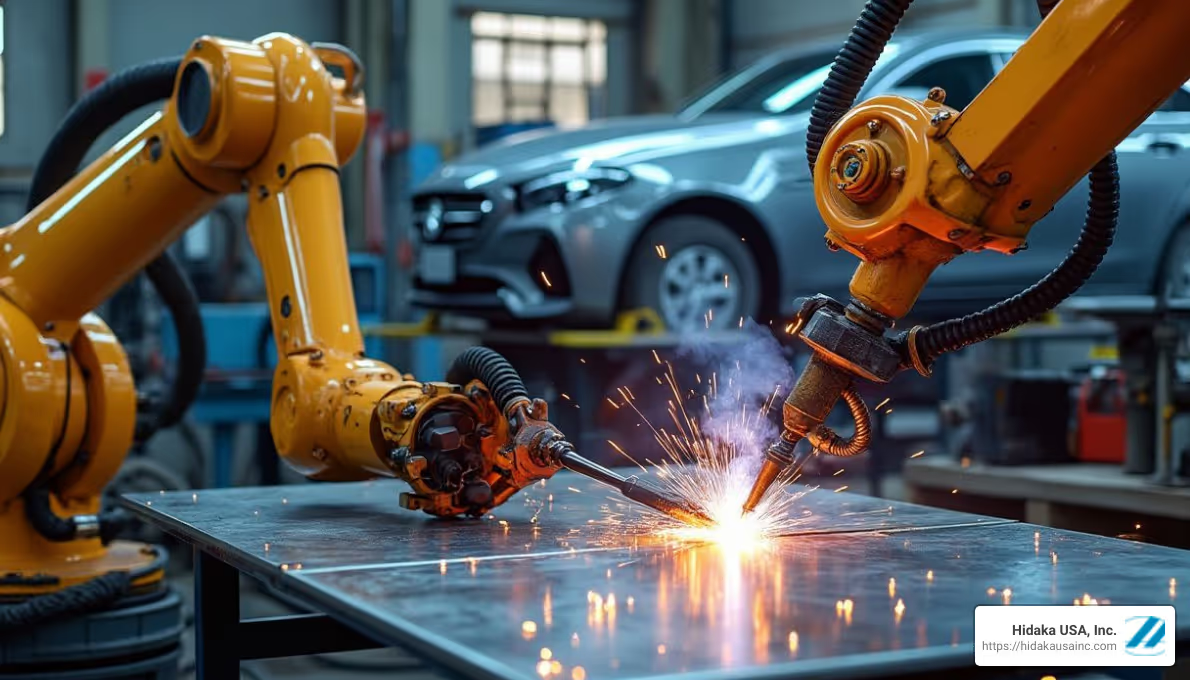
Each of these techniques has its own advantages and is suited for different applications. By mastering these methods, you'll be well-equipped to handle any auto body panel welding project. In the next section, we'll dig into manual welding techniques and how they can be applied to auto body panels.
Manual Welding Techniques
When it comes to manual welding techniques for auto body panel welding, understanding the nuances of each method can make a significant difference in the quality of your work. Let's explore the three main techniques: MIG welding, TIG welding, and Stick welding.
MIG Welding
MIG welding is a favorite among welders for its simplicity and speed. It uses a continuous wire feed as a filler material and a shielding gas, like argon or a mix of CO2, to protect the weld from contamination.
- Shielding Gas: The choice of shielding gas can affect the weld's quality and appearance. Argon mixed with CO2 is common for auto body work because it provides a stable arc and reduces spatter.
- Filler Wire: The wire used acts as both an electrode and a filler, melting to join the metal pieces. For auto body panels, a thin wire, such as 0.023-inch, is often used to minimize heat input and reduce the risk of warping.
- Ease of Use: One of the biggest advantages of MIG welding is its user-friendliness. The continuous wire feed allows for a smooth welding process, making it ideal for beginners and those working on straightforward repairs.
TIG Welding
TIG welding stands out for its precision and control, making it the go-to method when working with thin materials or requiring a clean finish.
- Precision: The use of a non-consumable tungsten electrode allows for precise control over the heat and weld pool. This precision is crucial for avoiding distortion on sensitive auto body panels.
- Tungsten Electrode: A 2% Lanthanated tungsten electrode is often used, sharpened to a fine point for better arc control. This results in minimal distortion and a high-quality finish.
- Minimal Distortion: TIG welding is preferred for projects where maintaining the original appearance is essential, such as restoring vintage cars. The controlled heat input helps maintain the panel's shape.
Stick Welding
Stick welding, also known as Shielded Metal Arc Welding (SMAW), is versatile and can be used in various environments, even outdoors.
- Versatility: Stick welding can handle a range of materials and thicknesses, making it a valuable skill for welders who work with different types of metal.
- Electrode Types: There are various electrodes available, each suited for different tasks. For auto body work, a smaller diameter electrode is often used for better control and penetration.
- Penetration: This technique provides deep penetration, which is useful for thicker materials. However, it requires more skill and experience to avoid burning through thin panels.
Each manual welding technique has specific advantages and is best suited for different tasks in auto body panel work. By mastering these methods, you can achieve strong, smooth welds that will stand the test of time. Next, we'll explore robotic welding techniques and their application in auto body panel welding.
Robotic Welding Techniques
In auto body panel welding, robotic techniques are revolutionizing how we approach high-volume production. These automated methods are not only about speed but also about achieving consistent and reliable results. Let's explore the key robotic welding techniques: MIG welding, Spot welding, and Stud welding.
MIG Welding
Robotic MIG welding is a powerhouse in the automotive industry, especially for high-volume production. Its automation ensures consistent welds, which is crucial when manufacturing thousands of car bodies.
- Automation: Robots handle the welding process with precision, reducing human error and allowing for 24/7 operation. This efficiency boosts productivity significantly.
- Consistency: With robotic MIG welding, each weld is identical to the last. This consistency is vital for maintaining the quality and safety standards required in auto manufacturing.
- High-Volume Production: The speed of robotic MIG welding makes it ideal for large-scale operations. It can quickly produce strong, durable welds, essential for the structural integrity of vehicles.
Spot Welding
Spot welding is a staple in factory applications due to its efficiency and strength. It is widely used for joining sheet metal in car bodies.
- Factory Applications: This technique is perfect for welding overlapping metal sheets, which is common in auto body construction. It's fast and efficient, making it a favorite in assembly lines.
- Efficiency: Spot welding requires minimal preparation and can join metals in seconds. This speed is crucial in a production environment where time is money.
- Strength: The welds created by spot welding are incredibly strong. This strength is essential for the safety and durability of vehicle bodies.
Stud Welding
Stud welding is used for attaching fasteners to sheet metal, providing crucial attachment points for various components.
- Attachment Points: This technique is perfect for securing bolts, nuts, and other fasteners to auto body panels. It ensures these components are firmly attached, which is vital for vehicle assembly.
- Sheet Metal: Stud welding works well with thin materials, making it a go-to method for auto body work where maintaining the integrity of the panel is important.
- Automation: Like other robotic techniques, stud welding can be automated to improve speed and precision, further improving production efficiency.
Robotic welding techniques are changing the auto industry by providing reliable and efficient solutions for auto body panel welding. These methods not only increase production speed but also ensure the high quality and safety of vehicles. In the next section, we'll discuss tips for minimizing distortion during welding.
Tips for Minimizing Distortion
Welding auto body panels often leads to warping, a common challenge due to the heat involved. But with the right techniques, you can keep your panels smooth and straight. Here’s how:
Understanding Warping
Warping happens when the metal around the weld shrinks as it cools. This can distort the shape of your panels. But don't worry, you can control this with a few smart strategies.
Cooling Techniques
Cooling is key to preventing warping. Allowing the metal to cool naturally between welds helps maintain its shape.
- Short Welds: Use short bursts instead of long, continuous welds. This reduces the heat buildup.
- Time Between Welds: Let the metal cool completely between each weld. Be patient—this can make a big difference.
- Heat Sinks: Place copper or aluminum bars near the weld area. These materials absorb heat, helping to keep the metal cool.
Fitup Adjustments
A good fitup is crucial for minimizing distortion. The better the fit, the less likely the metal will warp.
- Tight Gaps: Ensure the panels fit snugly together. Tight gaps mean less movement and less distortion.
- Clamping: Use clamps to hold everything in place. This keeps the panels from shifting during welding.
- Scribing and Trimming: Mark and trim the panels accurately before welding. This precision helps achieve a seamless fit.
Hammer and Dolly Work
After welding, use a hammer and dolly to correct any minor distortions. This technique helps stretch the weld area back to its original shape.
- Planishing: Lightly hammer the weld to even out any shrinkage. This technique, known as planishing, can prevent bulges and puckering.
The key to a smooth finish is controlling heat and ensuring a tight fit. With these tips, you can minimize distortion and achieve professional results in your auto body panel welding projects.
In the next section, we'll address some frequently asked questions about welding auto body panels.
Frequently Asked Questions about Auto Body Panel Welding
What kind of welding is best for car panels?
When it comes to auto body panel welding, MIG welding is often the go-to choice. Why? It's easy to learn and provides excellent results. With a MIG welder, you can achieve strong, clean welds without much hassle. This method uses a continuous wire feed and shielding gas, making it ideal for beginners and professionals alike. Plus, it works great on thin metals, which are common in car panels.
How do you prevent warping in thin metal?
Warping is a common issue when welding thin metal panels, but you can minimize it with a few key techniques:
- Cooling: Allow the metal to cool naturally between welds. Avoid rushing. This helps maintain the shape.
- Tack Welding: Use short, quick welds—called tack welds—to hold the panels in place. This reduces heat buildup and keeps the metal from distorting.
- Fitup: Ensure a snug fit between panels. Tight gaps reduce movement and warping. Use clamps to hold everything securely in place.
- Heat Sinks: Place materials like copper or aluminum near the weld area. They absorb excess heat and help keep the metal cool.
What safety precautions should be taken?
Safety is crucial in welding. Here are some essential precautions:
- Protective Gear: Always wear a welding helmet with the appropriate shade, gloves, and long sleeves to protect against sparks and UV radiation.
- Ventilation: Work in a well-ventilated area to avoid inhaling harmful fumes. Proper ventilation is key to a safe work environment.
- Equipment Checks: Regularly inspect your welding equipment for any signs of wear or damage. Ensure all connections are secure and the machine is functioning properly.
By following these safety measures, you can protect yourself while achieving excellent results in your auto body panel welding projects.
Conclusion
At Hidaka USA, Inc., we understand the intricacies of auto body panel welding. Our commitment to quality, expertise, and on-time delivery sets us apart in the industry. When you choose us as your partner, you're not just getting a service provider—you're gaining a team dedicated to excellence.
Quality is at the heart of everything we do. Our ISO 9001 certification is a testament to our rigorous standards, ensuring every part we produce meets the highest industry benchmarks. This commitment to precision and consistency means you can trust our products to perform reliably, reducing downtime and enhancing your production process.
Our expertise spans both manual and robotic welding techniques, including MIG, TIG, and Stick welding for manual applications, and MIG, Spot, and Stud welding for robotic solutions. This diversity allows us to tailor our approach to your specific needs, whether you're looking for prototype development or high-volume production.
On-time delivery is another cornerstone of our service. We know that timing is critical in the automotive and motorsports industries, and we pride ourselves on meeting deadlines without compromising on quality. Our streamlined processes and responsive customer service ensure that your projects are completed efficiently and to your satisfaction.
Ready to experience the Hidaka USA, Inc. difference? Explore our assets and capabilities to see how we can support your welding and manufacturing needs. Your success is our success, and we're here to deliver excellence every step of the way.


